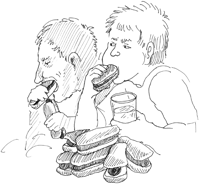STRANGEBUTTRUE- Contested eating: How to stuff your pie-hole and win

DRAWING BY DEBORAH DERR McCLINTOCK
Q. In a world where so much gets chewed over on a daily basis, it's not surprising that you can even read tips on how to win an eating contest. So, how? –E. Lagasse
A. We're not necessarily recommending this, but with good technique you too can become a gustatory champion, say world record holder "Crazy Legs" Conti and Johns Hopkins professor of medicine Gerard Mullin, as reported by Jen Trolio in Wired magazine:
1. First off, pick the right food. Rookies should cut their teeth on soft, single-component items like meatballs, funnel cakes and grits. Gradually work up to multi-textured bread-and-meat combos like hamburgers and hot dogs.
2. Eat strategically rather than just shoveling it in. With pizza, for instance, try the "reverse-fold," with the cheese on the outside acting as a lubricant and protecting your mouth from the abrasive crust.
3. For unimpeded consumption, breathe through your nose. A mouth-breather risks choking and wastes precious seconds stopping to gasp for air.
4. Divide to conquer. "Reversing" food means instant disqualification, so suppress your gag reflex by imagining the chow in smaller, more manageable portions. "Drink water to push vittles to the small intestine and free up your gut."
Q. Why does lovely music bring on goosebumps? –L. vanBeethoven
A. The hair-raising power of music is linked to adrenaline, with goosebumps occurring when tiny muscles in the skin (erector pili) contract and make hair follicles stand up, says Science Illustrated magazine. The hormone is triggered by various stimuli, from feeling cold to experiencing a strong emotion, such as when listening to moving music.
The semi-comic term "goosebumps" goes along with their uselessness, though they're probably a remnant of our primate heritage. They are still useful for animals whose bodies are covered with fur. When these animals feel cold, goosebumps can make the fur stand up, creating a heavier layer of insulation around the body.
"Goosebumps can also help animals ward off predators," the article claims. "Under threat, they release adrenaline, which makes their hair rise and helps them look bigger– and scarier."
Q. Do chimpanzees recognize themselves in a mirror? –J. Goodall
A. At first, they'll think they're seeing another chimp and try to make contact. But within days they'll begin making faces in the glass and trying to glimpse parts of their bodies they've never seen before.
When chimps were anesthetized and had one ear and one eyebrow dyed bright red, many of them later noticed this in the mirror, fussing at the strange-colored areas, says Richard Lippa in Introduction to Social Psychology. Orangutans also passed the dye test, displaying "self-recognition."
But lower primates such as rhesus monkeys and macaques flunked, as did dogs and rats.
Human babies catch on at age 15 to 18 months, noticing some rouge sneakily daubed onto their noses by researchers.
~
Send Strange questions to brothers Bill and Rich at [email protected]
#